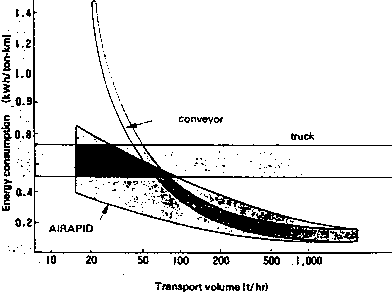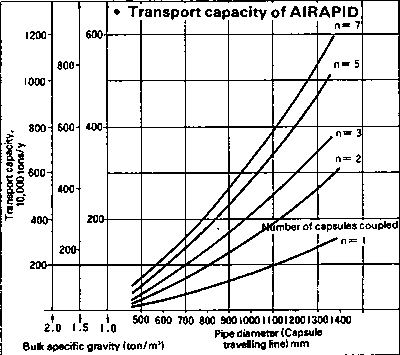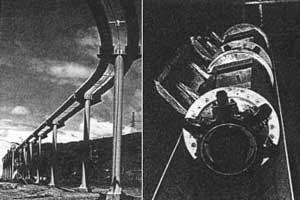Warning: The text reproduced here is a copy of information published elsewhere. This information has either:
- been published freely on the internet and has been cached here as a precaution against future loss of servers and links, or
- been published historically and very few copies of the original text are still available for research purposes.
It is recommended that you look at the original source given below first, and use this text only if that source is not available to you. It is not intended that any text cached here infringe the copyright of the original author. If any copyright owner wishes their text removed from this site, this can be done by contacting the author.
Document summary:
- Title: Airapid - Capsule-Tube Transport System
- Author: Daifuku Machinery Works Ltd/Nippon Steel Corporation
- Source: Promotional booklet Cat. No. PPE 101 52.11 (transcript by Tim Howgego).
- Copyright: Daifuku Machinery Works Ltd/Nippon Steel Corporation
- Date: Unknown, probably mid-1980s
New Transport System for Materials Handling
Increase in transport volume is creating serious social problems by aggravating traffic congestion and causing air pollution by exhaust gas, dust and noise. Conventional methods of transportation such as railways, trucks and conveyors provide only limited scope for solution to these problems. Accordingly, the development of new distribution systems is urgently required. In the field of intra-compnay materials distribution, environmental problems have become aggravated and efforts are being directed toward the rationalization of operations such as packaging, transportation, storage and materials handling with a view to reducing costs. This creates a strong need for the development of new methods of distribution.
The capsule-tube transport system (Airapid) is a new materials distribution system which has been developed jointly by Nippon Steel Corporation and Daifuku Machinery Works Ltd, to meet the needs of the times as described above.
Outline of 'Airapid'
Airapid can be used to transport all forms of solid and granular materials. Using this system, capsules containing the materials are propelled through pipelines by low air pressure.
This system consists of six basic components; pipeways, blowers, capsules, capsule-handling mechanism (including dispatching and braking mechanisms), material-handling mechanism and electriacl control equipement. Except for the pipe-ways and capsules, all other components are arranged in the stations installed at the starting and ending point.
1. Pipeway
The most economical pipe diameter is selected by taking into consideration various factors such as the type of material to be transported, material volume and transporting distance.
For bulk materials, for example, the pipe diameter is selected as follows in accordance with transport volume:
| Volume | Diameter |
|---|---|
| 1 million T/Y | 600-1,000mm |
| 2 million T/Y | 800-1,200mm |
| 5 million T/Y | 1,000-1,400mm |
The pipeway can be installed above ground, on the ground, underground or underwater depending on the surrounding conditions. The pipe may be of any shape; it may be circular, square or semi-circular, depending on the shape of the material to be transported.
2. Capsule
The capsule is a receptacle for carrying the materials. It consists of a container, wheel assemblies, pressure-receiving plates for receiving the wind pressure, etc. It has a very small running resistance and a large pressure receiving resistance.
The capsule may be open type (without cover), closed type (with cover) or pallet type, depending on the type of material to be transported. The volume to be transported at a time can be increased by enlarging the capsule or by coupling a number of capsules. The optimum capacity of a capsule and the number of capsules to be coupled are determined so as to achieve maximum efficiency having due consideration for conditions such as transport volume, layout, transporting distance, pipe diameter and dispatching intervals.
3. Blower
This is for generating the air flow necessary for propelling the capsule. As the running resistance of the capsule is very small, a main blower with a capacity of several tens of kilowatts will suffice for transporting one million tons of materials a year over several kilometres. If transportation of materials over a greater distance is required, intermediate blower stations (consisting of control equipment and an intermediate booster) are provided at appropriate intervals.
4. Materials-handling mechanism
This mechanism varies according to the material to be carried or the equipment of the preceding and succeeding processes. For bulk materials, the mechanism consists generally of a stock hopper, a conveyor, an automatic weigher, a surge hopper and a special discharging unit.
The most suitable materials-handling mechanism can be designed depending on the characteristics of the material to be handled.
5. Electrical control equipment
Up-to-date, highly reliable electronic control equipment are installed to make one-man control possible. Automatic tracking and control of operations, such as dispatching, travelling and stopping of the capsules as well as manipulation of capsules and loading and unloading of the material at the station is standard practice.
6. Capsule-handling mechanism
This mechanism consists of the following three units:
- Loading unit: This unit couples the capsule to the materials-handling mechanism at the starting point, moves the capsule to the loading point and sends it out into the pipeway. The unit may be of revolving chamber type, traverse type, or turn-table type depending on the scale and layout of the system.
- Unloading unit: This unit is designed to couple the capsule to the materials-handling mechanism at the ending point, to move the capsule to the unloading point and to place it into the return pipeway. This unit is also made in various types.
- Dispatch and control units: This unit controls the dispatching, stopping, braking and waiting of the capsules at the starting and ending points and the arrangement of the capsules on the line.
Reduction of transportation cost
The economical application range of Airapid and a comparison of transportation cost per ton-km by Airapid and by trucks and conveyors are shown below [table summarises graph].
| Method / Distance | Airapid (7m above ground) | Truck (Road construction cost included in parentheses) | Conveyor (7m above ground) |
|---|---|---|---|
| 50km | 21 | 31 (42) | 30 |
| 10km | 24 | 36 (47) | 30 |
| 3km | 29 | 50 (60) | 30 |
Airapid is a sufficnetly profitable system for transporting bulk materials in hundreds of thousands of tons per year over a distance of several kilometers and also profitable for transporting general commodities even in small quantities. Where the plant layout and traffic are congested, this system offers great advantages which cannot be expressed in figures, such as savings in space and time.
Most economical 'fixed time, fixed volume transport' system
As the capsules run through the pipeway, materials can be carried reliably without being affected by weather or traffic conditions. This system can solve problems associated with conventional systems, making it possible to realize 'scheduled delivery and scheduled arrival'.
Most suitable for energy savings
Transportation by trucks requires a fixed amount of energy, regardless of the volume to be transported at a time.
If Airapid is adopted, the energy requirement per ton-km decreases with increase of transport volume. This is a system which is comparable to conveyors in enegy efficiency.

Ease of maintenance
The pipeway which is the largest part of the system has no moving parts and requires little maintenance. The capsules are of simple robust construction, and maintenance is both easy and minimal.
Since almost all the mechanism is installed in the station, it can be controlled very easily in centralized manner.
Comparison of various transport systems
Comparing the characteristic features of various transport methods are shown below, it will be seen that Airapid is advantageous in almost all aspects.
As regards initial investment, Airapid is more advantageous than other systems (railways, conveyors, etc) as long as it is used in the economical application range as described previously.
| - | Airapid | Truck | Conveyor | |
|---|---|---|---|---|
| Delivery | Speed | 30kph | 20~100kph | 5~20kph |
| Delivery time | Prompt | Irregular, affected by traffic | Prompt | |
| Convenience | Transport item | Wide variety | Wide variety | Wide variety |
| Combined distribution | Suitable | Suitable | Unsuitable | |
| Equipment | Line | Pipe | Road | Conveyor (hood required) |
| Vehicle | Capsule (power control device not required) | Truck | Not required | |
| Cost | Medium | Low | High | |
| Maintenance, manipulation | Maintenance | Capsule maintenance easy, line need little maintenance | Truck needs maintenance | Many points to inspect (large number of parts) |
| Manipulation | Small number of operators | Easy, but each truck needs driver | Small number of operators | |
| Cost | Comparatively low | High labour and maintenance costs | Very high maintenance cost | |
| Efficiency | Power | Centralized power, air flow | Independent power, low engine efficiency | Decentralized power |
| Loading capacity | Large | Small | - | |
| Control | Automatic, labour saving | Centralized control | Manual | Automatic |
| Cost | High | - | Low | |
| Safety | Safe and clean because of line shielding | Traffic accidents, vibration, damage to goods | - | |
| Pollution | No pollution | Exhaust gas, noise, accidents | Noise | |
| Space occupied | - | - | - | |
Safe, pollution-free, clean transportation
The capsules are propelled by air enclosed in the pipeline, and the system does not produce exhaust gas, odor, noise, vibration, etc. This is a safe, pollution-free, clean transport system which does not adversely affect operators or surroundings.
Transportation over short to long distances possible
Technically, the transporting distance by this system can be increased infinitely if intermediate blower stations are installed at appropriate intervals.
Wide application range
Making the most of its advantages, such as freedom of cross-sectional shape of pipe, unlimited pipe installation distance and all-weather construction, the system can handle a wide variety of materials.
This system can be advantageously used for transportation of machinery and materials in the plant and for transportation of garbage and commodities in the city.
Airapid can be installed anywhere
Depending on the conditions at the place of installation, the pipeway can be installed above ground, on the ground, underground or underwater without special consideration for circumventing natural or artificial obstacles such as roads, rivers, lakes, bays, railways, bridges and buildings.
Large transport capacity
The transport capacity of Airapid can be increased to millions of tons annually per pipeway by (1) increasing the number of capsules coupled, (2) shortenig the dispatch intervals and (3) enlarging the capsule by increasing the pipe diameter. If larger transport capacity is required, it is economical to install a plurality of pipeways in the same manner as with railways and conveyors.

Ideal for in-plant transportation
Methods of in-plant transportation must be free from noise, vibration and collapse of the load and be easy to maintain. Airapid satisfies all of these requirements. It may be said that the pollution-free Airapid perfectly meets the need for a cleaner atmosphere in the plant.

Prototype no.1 Airapid is in operation at Muroran
Nippon Steel's Muroran Works is using Airapid as a new system for the transportation of burnt lime to its no.2 steelmaking plant. This system has completely replaced he conventional method of transportation by truck.
Basic specification of Airapid at Muroran
- Transport item: name: burnt lime, bulk specific garvity: 1.07ton/m^3, shape and size: lump lime of 10 to 30mm (containing a small quantity of fines).
- Transport volume: monthly transport volume: 20,000tons, monthly operating times: 550hrs (standard).
- Pipeline: pipe diameter: 609.6mm, pipe installation: elevated 7 to 8 metres above the ground, transporting distance: approximately 1.5km.
- Transport system: capsule: train of two capsules, capsule dispatch intervals: 45 sec (minimum), unit transport volume: 500kg/train, capsule running speed: approx 6~8m/sec.
- Power required: main blower: 75kw/1, auxiliary blower: 36kw/12.
Contact details
Nippon Steel Corporation: Head Office: 6-3 Otemachi 2-chrome, Chiyoda-Ku, Tokyo 100, Japan. Phone: (242) 4111.
Daifuku Machinery Works Ltd: Export Department: Gotanda Dai-ichi Seimei Bldg., 19, 2-chrome, Nishigotanda, Shinagawa-ku, Tokyo, Japan. Phone: (494) 5861.